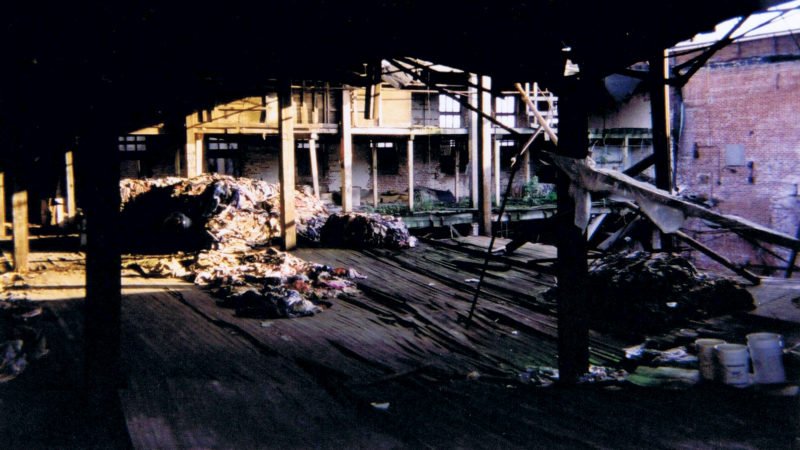In the ’90s I knew a young woman who was assaulted on the steps of a university library. She was walking home late at night, carrying a bundle of sunflowers. Fifty sunflowers, maybe sixty, with heads as wide as salad plates. A man snuck up behind her and pressed a pistol into her back. He raped her there, on the library stairs. He spat on her neck. And then, as if the violence weren’t enough, he stole her flowers.
I watched my back when walking home late at night.
The aughts were plagued with security.
I never hung blinds or curtains in my windows. Not until I moved into an apartment with someone I mistakenly loved. He hated the sodium streetlights, how they yellowed our bodies when we undressed. He didn’t know what they were called, I had to tell him. It was then he began to use my language, my “sodium streetlights,” in his stories. He adopted my “nine o’clock blue.” My favorite color of sky. He hung it over the women in his fictions. Kidnapped women, women stuck with pins, women so mannish they were mistaken for Thomas Pynchon.
A shared language won’t save you. The pastoral won’t save you. Security won’t save you. The aughts taught me this.
At the end of the aughts, I met a woman who’d known a woman who’d rented a studio at 5 Pointz in Long Island City in the ’90s. What the building lacked in structural integrity and reliable lighting in public spaces, it made up for in cost and community. Its façade was alive with graffiti. Wildstyle, they call it. Piece for masterpiece. Her rent was cheap because the room lacked heat, the windows lacked locks, the freight elevator permanently jammed in its shaft.
When she wasn’t painting, she was kickboxing. After training, she’d hoist her bike onto one ripped shoulder and climb five floors of rusted scaffolding into her studio window. Every day until the day the scaffolding collapsed.
Have you ever been afraid of a stairwell?
I deboned myself.
My favorite color of frosting
was red, yellow, orange.
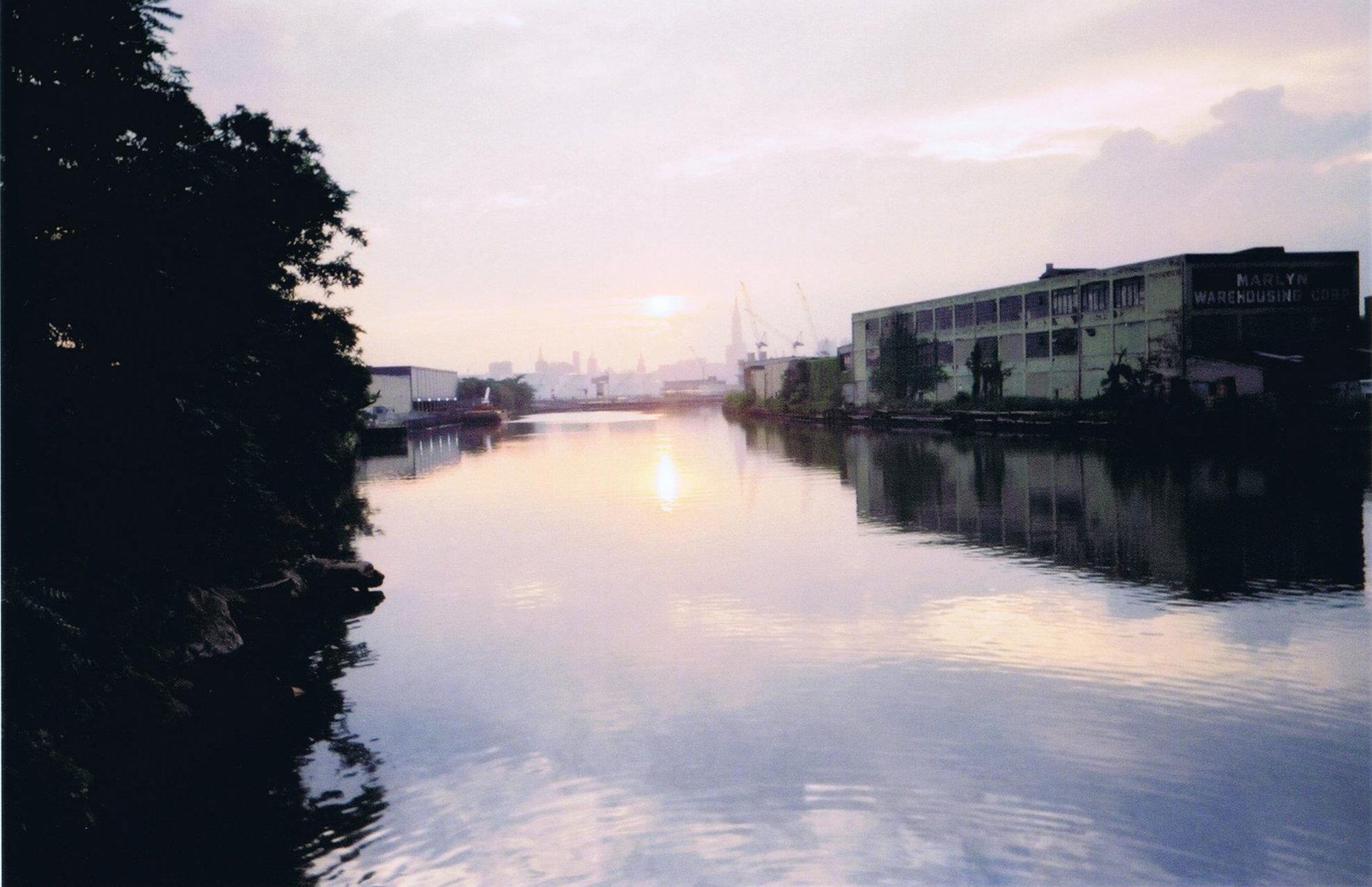
The man I mistakenly loved interviewed artists for glossy magazines. I read every Q&A transcription. I scanned for difference; I wanted to discern where unrehearsed sentiments and unguarded gestures popped out of the PR-mediated copy: moments when a question hit a nerve, where the text seized on an artist’s authentic voice. Afterwards, I’d ride my bike over the Pulaski Bridge, pumping the pedals in a sprint from Long Island City to Maspeth. I’d thumb my disposable camera, framing the blank billboards and the pink and green dregs of Newtown Creek, imagining I was an artist.
Q: How is it that some places on earth, no matter how remote, are able to present themselves as the path of least resistance?
A: I purchased bulk packages of disposable cameras at my local pharmacy and kept at least one on me at all times. I wanted to remember my world the way that I had experienced it, not in the way the media or any other artist would have me remember it down the road. I wrote my own future past. The aughts were years of lost things. No, that isn’t true. They were years where anything and everything kept coming back for one last go—like an ex in a dry spell or a Labrador with a tennis ball. My photos economized my hoarding. I had a problem with hoarding in the aughts. A glass strawberry, an amethyst biscuit, a porcelain turnstile paperweight hand cast by the owner of a very important start-up.
Q: Gateways to past selves?
A: I didn’t know it then. That I was method acting.
A: I approached my body the way sculptors approach material. The narrative is alive within it; the sculptor must shear anything that isn’t its truth. This is method acting: to excavate the depths of one’s experience and discard all that isn’t truly suffered.
Late night in the aughts, at least two years before GPS, Google Maps, and Mapquest, an unmarked car would idle at a corner near the Graham stop on the L train. The driver would ask a young woman for directions. The woman, most likely new to Brooklyn, most likely a gentrifying artist (they had a type), was on her way home. If she paused, three doors would unlatch and the men—they each took a limb. Can you see her struggle?
Her body most frequently surfaced in Queens.
One night, walking a friend’s dog, I hinged a corner and faced him: wide-boned, blond hair, gold chain. In the streetlight’s tangerine glaze, two more looked exactly like him. One wore a burgundy leather jacket. A driver’s cigarette, a red pinprick beneath a sunshade. Rust acne inflamed the sedan’s skin of blue paint. No license plate.
I apprehended all of this in the time it took for the lucky screw I carried in my palm to ping on the sidewalk and bounce out of sight.
“My friends, we need a light,” the man said. The dog barked. The men recoiled. The man with the cigarette spat and said, “It’s a fucking dog, you pussies!”
I sprinted past them—dog leash seared into the flesh of my hand. The welt curved like a lifeline.
My fear of abduction, of erasure, seeped into my language. I developed a fascination with the homophone’s semantic peril, the homophone’s spoken risk. For example: tulle and tool, heal and heel, steal and steel. If the listener isn’t really listening, one meaning hazards erasure; if the listener doesn’t recognize the homophone; if the listener doesn’t invest in the interconnectedness of sound and context and meaning.
In the aughts, I learned that the reach of a steeple bell once defined a church’s parish. Where the sound perished, so did the word.
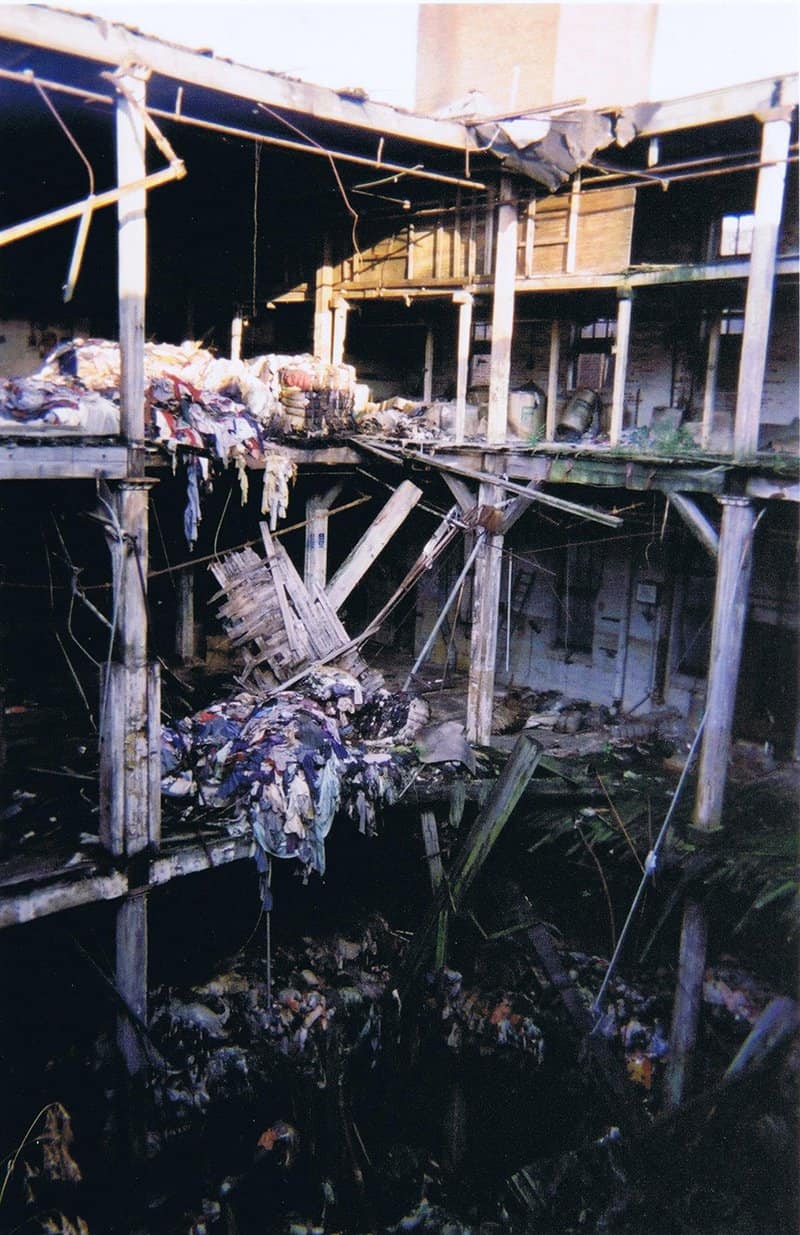
One morning at the coffee shop, a regular struck up a conversation as I fixed his latte. He wanted to know what I did, not what I did for money. I told him I broke into abandoned buildings.
I told him about the Greenpoint Terminal Market, how my coworkers and I had shimmied up a waterfall of polyester clothing, cracked pipes, and insulation—a slew of debris almost thirty feet high—and how we slid down the fabric hills at the center of the warehouse, sledding on coats like cartoon penguins. I told him we’d scaled a wall using only bricks and hooks to hoist us; how we’d climbed the elevator shaft up to the roof; how we lay on the ledge overlooking the aluminum crinkle of the East River and let the sun bake our limbs as pigeon shit dried into chalk on our clothes.
“You privileged idiot,” the customer said. “You make a playground out of an eyesore. It’s condescending. It’s ruin porn.”
Sir, I could argue for and against porn, for and against playgrounds and ruins.
Q: Tell me a little something about pictures. Your pornographic pictures.
A: I developed one roll of film per week, kept the photographs in envelopes stacked in a cardboard box. When I subleased my room, I stored the box at my mother’s house. I placed it next to my desk in my old bedroom. When I returned from Eastern Europe two months later, the box was gone.
Q: This is how you lost your photographs of the Greenpoint Terminal Market.
A: The aughts were years of lost things.
Q: And the building itself, it was a pornography?
A: The rooms were as long as basketball courts. They were filled with polyester clothing. The bundles were large as shipping containers, strapped in canvas and banded with rebar. In some rooms, where the ceiling leaked, their damp weight caused the floorboards to collapse. You could balance on a beam and gaze down into the wreckage. Ailanthus sprouted from the walls.
Disillusioned by the accessible, I wanted what was forbidden; intact, I wanted what was beyond repair. Like a soldier in a remote barrack pilots a drone across the planet, I wanted to tap the significance that dwelled in concentric circles of trespass around a notorious target. I wanted to drill my way into the center of something in a world of steadily increasing surfaces. I wanted the glass walls that keep me separate from you to become as permeable as air.
Our songbirds evolved to migrate
nocturnally, when predators
retire and winds die, but now,
in the sky above the Tribute
in Light, whorl in the white floodlit
condensation. Smog, particle
suspension, whatever the news
calls the stale fractal void, birds flit
between its bright spokes and the
dark site, impossible to track
any one bird for any length
of time as they coil, blind and
wailing in the bold false dawn that
lured them inside the fingerprint.
I felt the spiral—was it History? My LiveJournal theme was the color of my flesh, but I didn’t feel the need to be honest in the way I portrayed my life online. I experienced the Internet and the American government as a series of distinct betrayals: fake profiles, joblessness, pop-up ads, medical costs, taxes that mostly supported the military, Boomer disdain followed by the disdain of Gen X, the new gatekeepers who had suddenly realized that what they wanted (aside from flex time, authenticity, and the right to publicly sulk) was what their predecessors wanted—income, stability, family, homeownership, legacy. Maslow’s hierarchy of needs came as a wide-paneled stepladder for those with privilege, but not for most.
9/11 united Americans, for a brief duration. I joined 500,000 bodies in the bone-cold march against the Iraq War in February of 2003. Riot police in Stormtrooper costumes lined the roofs of federal buildings and the grassy knolls of the National Mall. The numbers reported in the news hardly reflected our masses. Troops were deployed despite us. Narratives of vengeance, expansion, and greed masqueraded as narratives of solidarity, pride, and charity. Masqueraded as origin myths.
Operation Active Endeavour, Operation Enduring Freedom, Operation Iraqi Freedom, Operation New Dawn.
As a girl, I knew the phrase “a shot heard around the world” before I could tell you what the world was.
The things Americans are most proud of originate in a bang.
In the aughts, I knew about the Big Bang, but I had no sense of a discrete origin or an original unity. I was eager to side with science, but reluctant to believe the world ballooned from a single violent burst. Johan Galtung taught me how the cosmogony and cosmology of a civilization act as a sociocultural code, a kind of DNA that determines how a culture will perceive reality and that carries instructions for assembling a culture’s structures, from artworks to statecraft. With what options did the Big Bang present us?
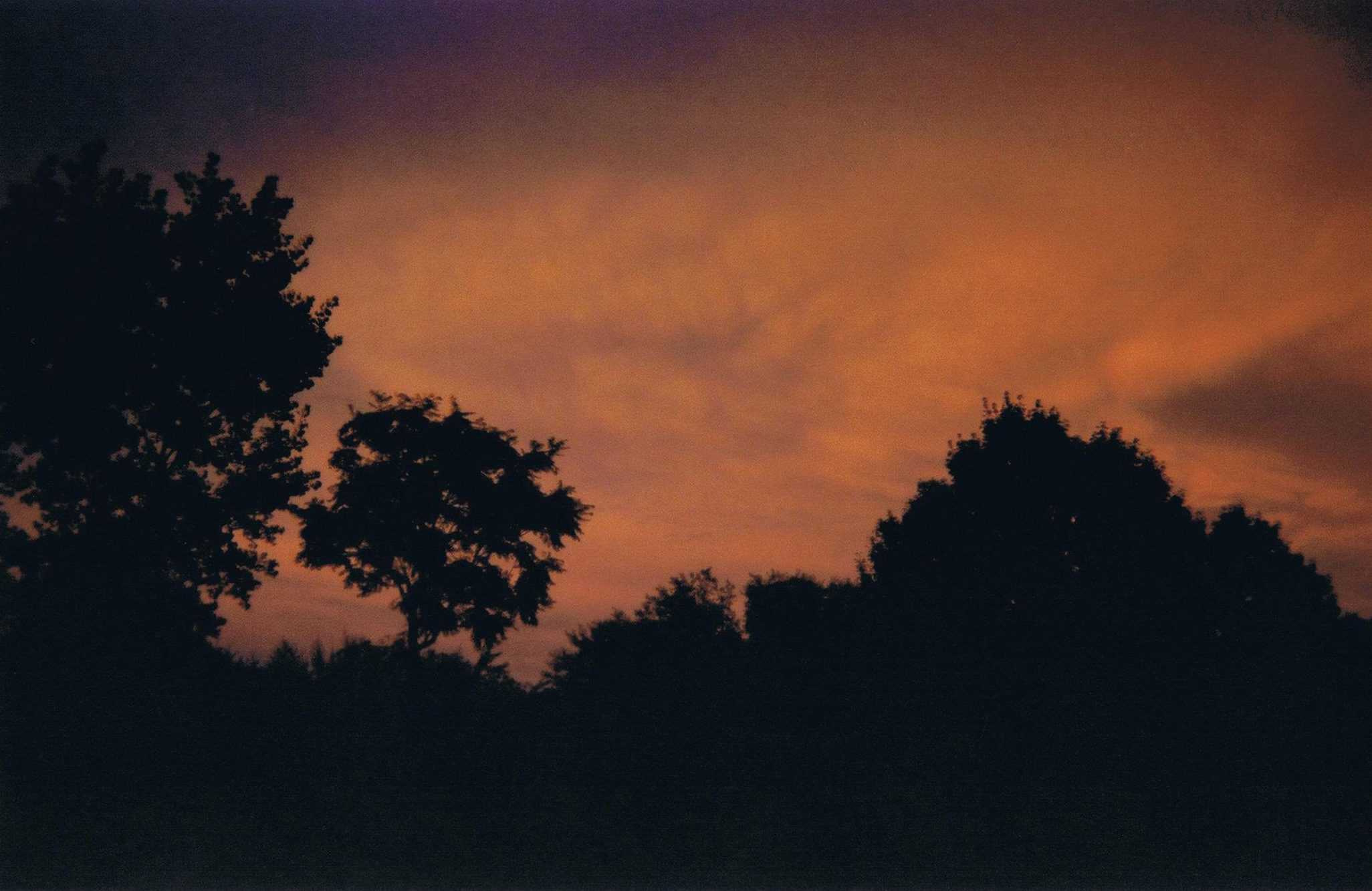
The late aughts’ trickle-down emergencies, a litany of origin stories: new human emotions that haven’t yet been named; malignant cancers unfurling hourly; the urge to quit my job and leave the country; an assortative adoration for an unknown equal I couldn’t locate; soft streetlight humidity, ailanthus boughs in the open window in lieu of A/C, the feeling they stirred in me. Not the data but our relation to it. Not the fallout but the calibration of our instruments.
The sun slipped behind the strand of oaks, disclosing the city’s orange bruise beyond the treetops. On the television, a newsflash: an “active shooter situation.”
In the aughts, the opposite of cause is not effect. The opposite of cause is the cause’s reverberation.
George W. Bush strummed a guitar as the levees failed. Eminem released a movie; I downloaded “Lose Yourself” (MP3, free). I saw Damian Hirst’s “The Physical Impossibility of Death in the Mind of Someone Living,” the shark suspended in formaldehyde, at the Metropolitan Museum of Art. I tapped on the glass. The docent didn’t notice. (Neither did the shark.) Chris Ofili used scat to paint. Dash Snow jerked off into a pile of tabloids. (The New York Times called it “appropriation, collage, erasure and drawing.”) I saw Edward Burtynsky’s Brooklyn Museum retrospective, his C-prints of shipbreaking in Bangladesh, uranium tailings, copper and marble and mineral mines, heaps of discarded circuit boards, tires, and wires.
The old art was rotten with materials.
In retribution for the decay, pop art expanded to hyper-completeness. Jeff Koons’s “Balloon Dog,” its candy-colored stainless steel iterations, delivered their cohesive shells. They reminded me of my roommate’s cluster of iMac G3 carcasses: blueberry, strawberry, tangerine, grape, and lime. I wanted the “Balloon Dog” sculptures to be as compact as Skittles, as dense as Starbursts, as hard as Jolly Ranchers, but the sculptures’ centers were empty. They were bubbles. I’d experienced a similar disenchantment the first time I bit into a chocolate Easter bunny and discovered the treat wasn’t solid, and again, when I plucked a frosted rose from a supermarket cake and the sugary crust dissolved in my fingers. All that is solid melts into air. (Marx)
Giuliani cleaned up New York City. I rode the subway from Times Square to Brooklyn, strolled home unaccompanied and mostly unaddressed. The last time I was assaulted on the subway was at rush hour at the end of the ’90s. The car was packed. I was seated, engrossed in Mary Gaitskill’s Because They Wanted To, when a man opened his camel-hair coat and tried to coax his erect penis into my mouth. Immersed in Gaitskill, I mistook it for the butt of an umbrella and batted it away with my book. I only realized it was a cock when I registered a yeasty smell. I exited swiftly at the next stop.
This never would have happened after 9/11. Right after 9/11, I wouldn’t have frozen. I would have mauled him. Or he wouldn’t have been there. After 9/11, he would have been a cop.
Cops manned the subway cars in quads and pairs. Navy-blue petals on a black bough. Late night in the aughts, I watched two cops sleep standing up. Their bodies swayed with the engine.
A good girl, I had a recurring dream
my name was Ajax, and on the field I came
and fell, though I didn’t fall
as Ajax fell. I woke from the dream.
Or became something else.
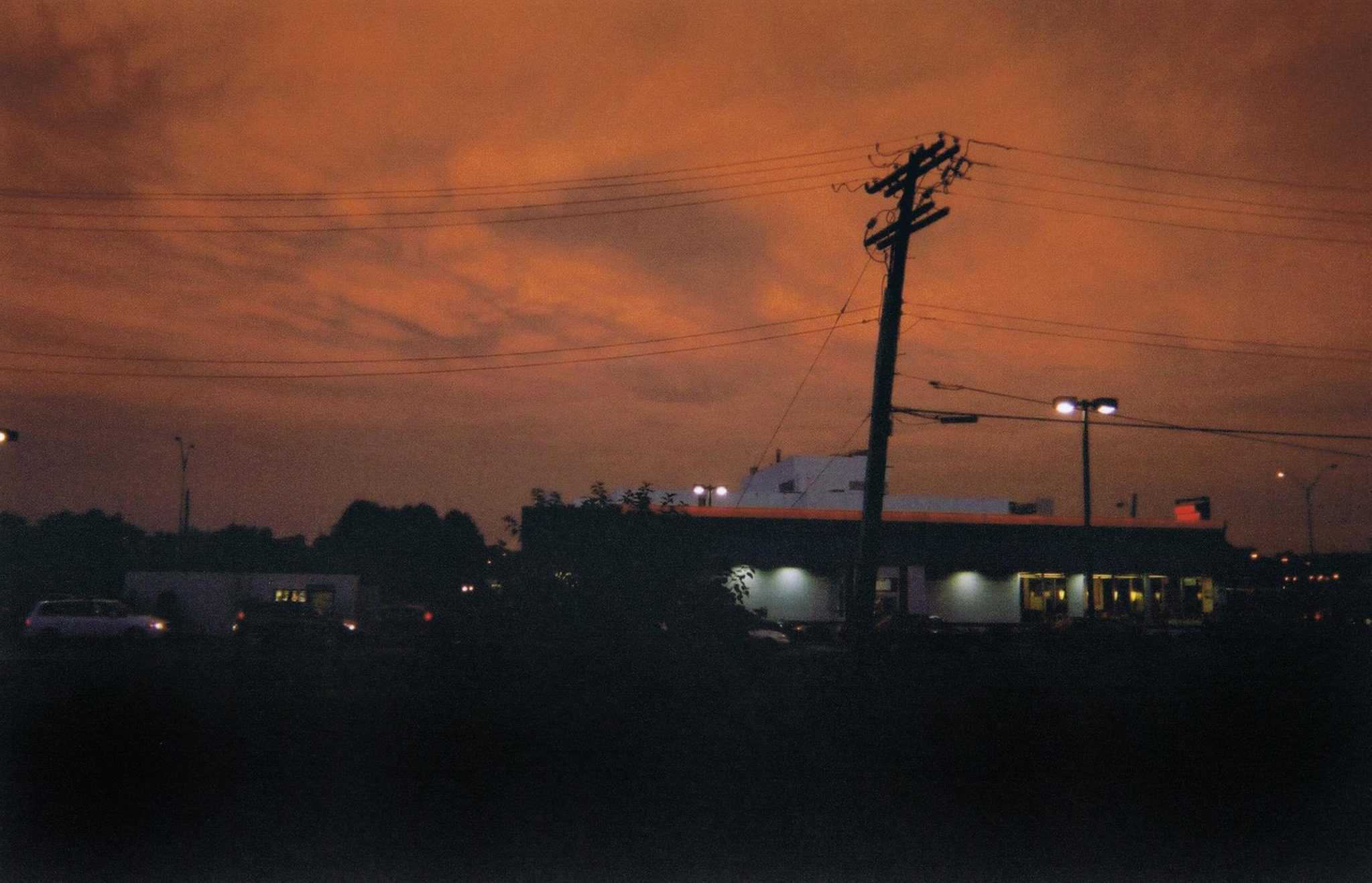
Almost immediately after 9/11, Great American Novelists set down their suburban realism to investigate the superhero psyche: What would it be like to have power? What would it be like to be a force?
The novels weren’t concerned with truth of the superhero lifestyle, but whether or not the story worked. Whether or not the story was loyal to its own internal logic. Whether or not the superhero’s struggle translated as sincere. The drive of psychological superhero fiction is to investigate the human burdens of power; to expose the strain of power’s responsibility; to make visible the real man behind the stupendous acts, the bold drag, the boasts and brags.
Transparency was an emergent feature: Wikileaks distributed documents from the Iraq War in the name of transparency. Investigators demanded transparency regarding journalists’ CIA sources, the same transparency the NSA commanded from American citizens. The transparency of logged keychain searches, character strings, the click-prints we dribble as we tap, link, and share; the transparency of networked medical records, phone bills, credit card statements, Netflix and YouTube streams; the transparency of TSA X-rays, pat-downs, rub-downs, and strip-searches; the transparency of tell-all confessionals and Who Wore It Best? and nanny cams and sex tapes and vapor suspension nanotechnology and strip mall radiology; the transparency of unencrypted mobile banking data; the transparency of evidence.
Never forget: when we identify with the superhero, we empathize with power.
A man with X-ray vision can disrobe you without your consent.
“Abjection becomes splendor,” writes Deleuze. “The horror of life creates a very pure and very intense life.” In the aughts, an abject life, a life that survives its horror, is a life charged with intensity.
An origin story: Midway through the aughts, I flew to the Baltic. I’d studied Eastern Europe in a human geography course, spurred by an interest in my grandmother’s flight to the United States when her village was forcefully relocated by Polish and Soviet soldiers. Discouraged by the political climate in the United States, exhausted from the constant derision I faced at my barista job, frustrated with art and relationships, I wanted to place an ocean between body and my past. When I arrived in Tallinn in January of 2004, Estonia hadn’t yet joined the EU. Facebook hadn’t yet become a global corporation. My mobile phone was a useless stone. It was easy to disconnect.
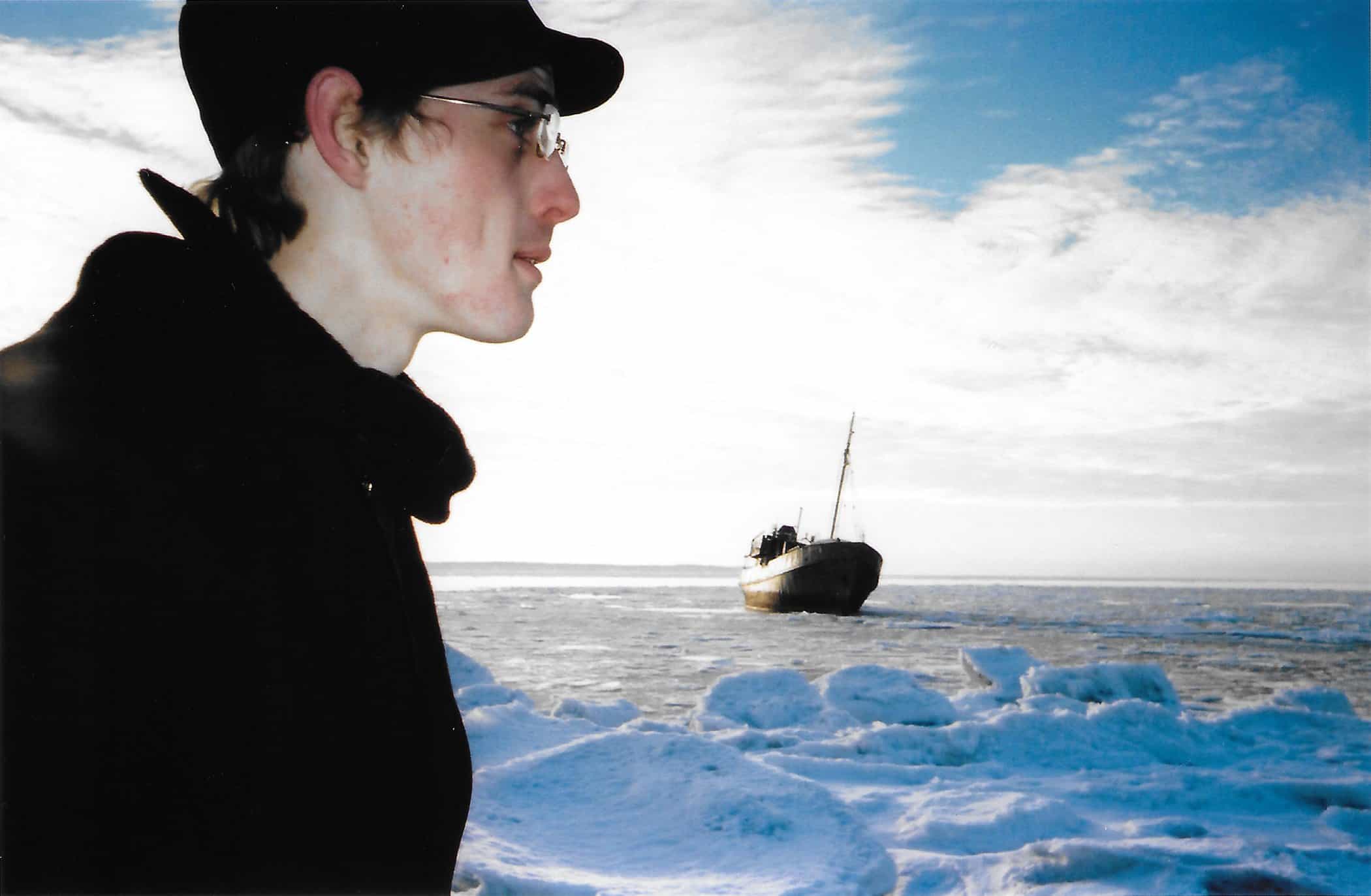
J introduced himself in a basement bar where we’d both taken shelter from a blinding snow squall. Although J was Swedish, he spoke Estonian and read Cyrillic, which enabled him to work full time as a bike messenger for a courier company specializing in telecoms staking territory in the new economy. The EU and its investments were arriving. J had biked to Tallinn from Bauhaus Dessau, where he’d been researching systems of connectivity in global modernism, suffered a nervous breakdown, and fled. He’d ditched everything except his black uniform, wool cap, bike, and backpack. In the basement bar, he confided how earlier that day, his boss had lashed out at him. In retribution for his employer’s slurs, he’d stolen a classified map. His company had been the only Estonian entity trusted by the USSR to transport military messages during the occupation and the stolen map detailed the town of Paldiski, the site of a Soviet nuclear submarine base, located on the Baltic coast. Originally a medieval Estonian village, the town had been converted into a Russian military barracks and microdistrict during the occupation. The map revealed the base’s outbuildings and underground docks, including several points of entry where we could descend and board the submarines, which, according to a rumor, were intact.
Outside the bar, the snow ebbed. With his bike in one hand and his backpack in the other, J walked me to my hostel. He invited me to join him in the morning on the train to Paldiski. No pressure, he insisted. If I decided I didn’t want to go, he would understand.
“Even to Achilles, the moment comes; he too must shake and stammer with fear, though it is a river that has this effect on him not a man.” (Weil)
I met J in the morning at the Tallinn train station. We bought pastries in wax paper and wandered the tented market that sprang up daily along the tracks. He rifled through a vendor’s used army gear: wool pants, wool jackets emblazoned with geometric patches. Aluminum gun tripods. There were shelves stocked with armies of rubber dolls; animals with plastic teardrop eyes and mushroom-stump legs; steel clips in tin pans; rusted cartoon carnation pins.
From my studies, I knew enough about Estonian history to recognize the carnations as cornflowers. The cornflower, a blue wildflower that grows in rye fields, is Estonia’s national flower. The blue stripe that runs through the middle of the national flag is cornflower blue.
Under Soviet occupation, cornflower decorations were banned from public spaces. The blue petals were painted over with red enamel; in vases, flowers’ stems were fed red dye and renamed. The symbol gained potency. Blue endured below the red bursts. Embroidered carnations connoted undisclosed sentiment. The gift of a bouquet handpicked from the rye fields bloomed with meaning. Men wore cornflower stems in their buttonholes as a silent pledge.
I ran my fingertips over the buttons. Collectibles were out of my budget; I had only enough cash for the train. I wasn’t sure if I should call them collectibles—if they were jewelry, adornment, if they were artifacts. If they were significant enough to be imbued with History’s dignity, or if I should’ve called them memorabilia, souvenirs: little memorials, objects not to archive but to thumb until the color rubs out.
J reached up and plied a gas mask from an array of ventilation tubes, chemical goggles, sound-damping earmuffs, and other assorted military paraphernalia that dangled, bunched in clusters like grapes, from fishing nets nailed to the ceiling of the stall. He tapped the masks with the fascination of an infant grasping for a mobile. The masks were for sale—to remember, or to use?
Once we were on the train, J unfolded the map. It was smaller than I’d imagined, the length of my forearm. We smoothed it across our laps.
Landscape scrolled through the window’s frame: gray and yellow houses, a backyard garden’s plump snow loaves, barbed wire’s split ends, blanched tarpaulins. A byway of frozen mud puddles was replaced with ribbons of blue and red and pink graffiti. Where the graffiti frayed: open land, a cubic palette of gray, raw umber, soft black hardened to titanium white, alcoves of spruce and pine, a stone home, smoke billowing from its chimney, birches poking up from the ground like singed filaments of light bulbs .
On the train, I forgot how I relished privacy. I wanted to share this.
An origin story: In the aughts, I devoured Simone Weil’s essay “The Iliad, or the Poem of Force.” Weil makes visible the propulsions beneath war’s surface tension. She shows us how we use language (the simile) to glorify our soldiers as “fire, flood, wind, wild beasts”—nature, set into motion by the violence of external forces. On the surface, powerful, but nature has no free will. What appears glorious is ultimately reductive. Who is responsible for the effects of war if our soldiers’ and leaders’ actions are directed by gods, predetermined?
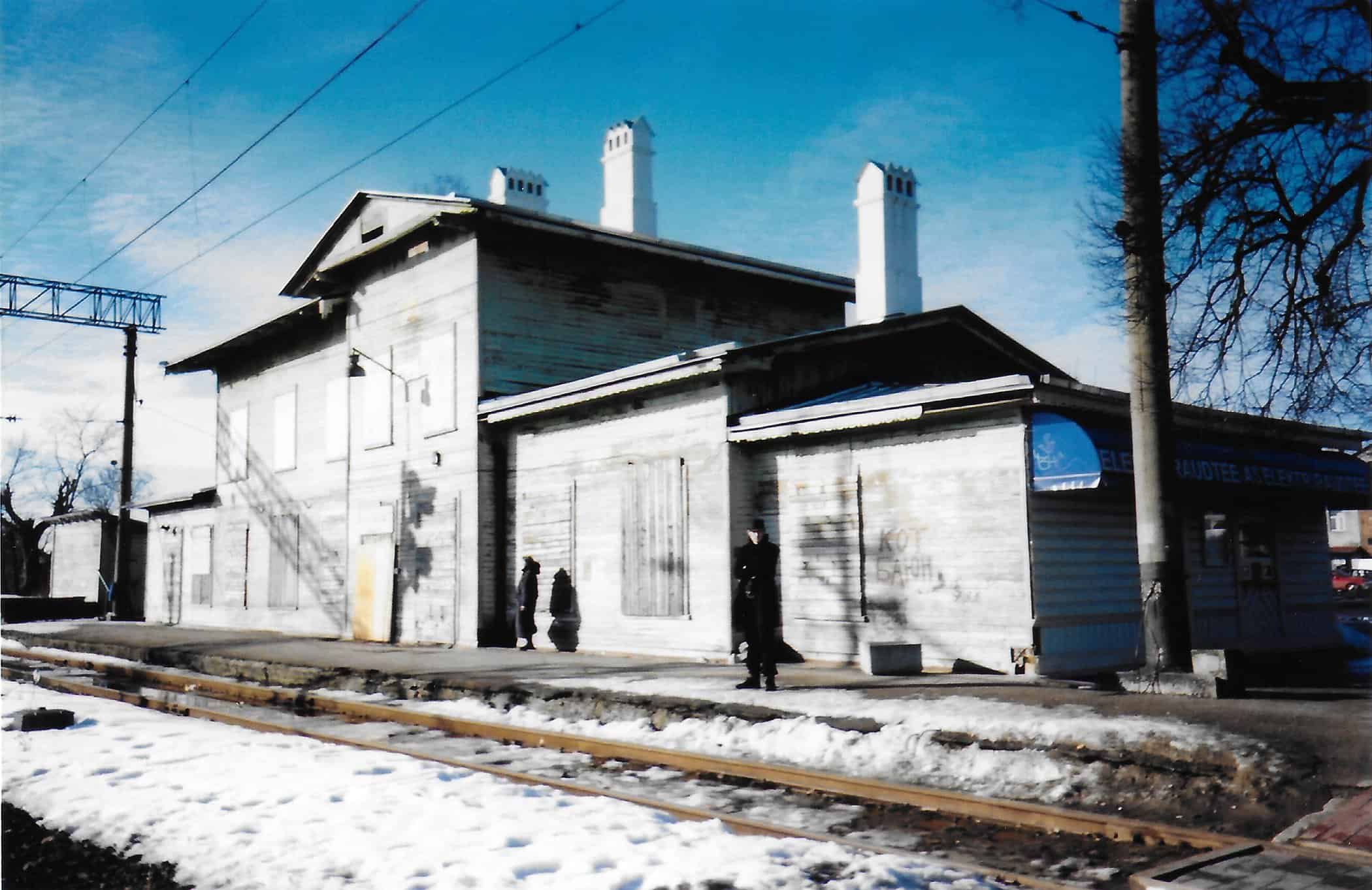
J and I arrived at Paldiski. The barracks, whose fragmented outer walls and rafters recalled the shells of desiccated beetles, spilled into a residential microdistrict at the end of the train yard.
The easternmost district blocks appeared to be occupied. Their yellow paint was badly oxidized; vertical cracks sprouted between units, reinforced with the same tar that patched the potholes in the street. To the west, the units weren’t so fortunate. In the midday shade, their green eggshell coatings were chipped, flaking in patches like eczema, revealing concrete and insulation. Windows were cracked or missing, with gaps like knocked-out teeth. Dead nettles withered along the sidewalks. In a planned community designed to promote equality, an uneven distribution of structural decay pocked the cultivated sterility.
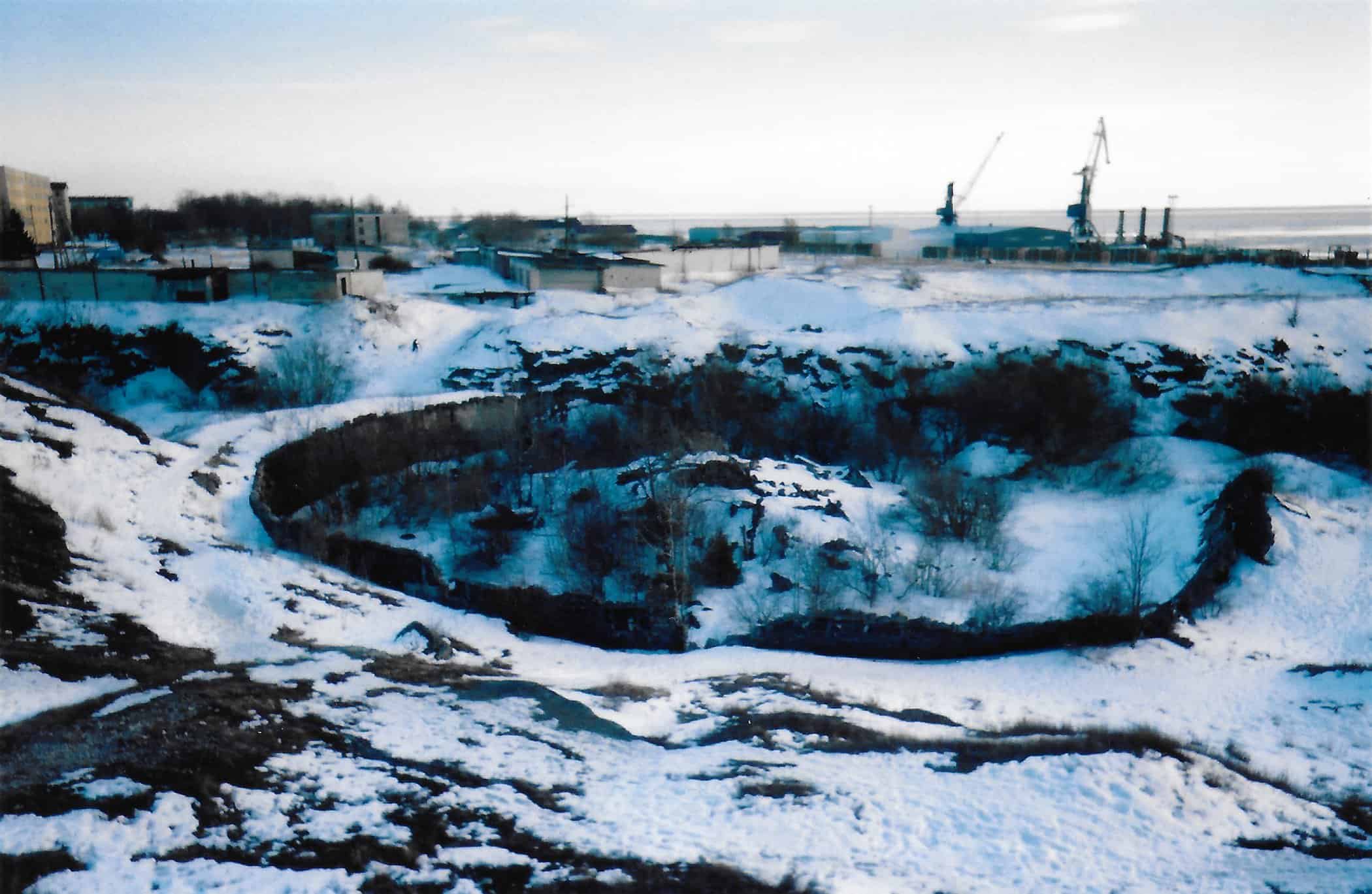
In the vestibule of a green building, the dirt floor was littered with broken bottles, foils and wrappers, cartons and boxes. The walls were streaked with flared scars, burn marks from an aerosol can aimed over a lighter. Someone had tagged the wall: a flutter of resistance. I thought of the Brooklyn waterfront, the Greenpoint Terminal Market—its ailanthus a lush forest, shades of green layered on concrete’s orange, purple, and yellow zigzags; slabs that read “OBSOLETE MACHINES” and “LOVE LIES / HERE” like tombstone engravings; an octopus in a spacesuit like a communiqué from a future where, submerged in air, language has retracted into pictogram.
Graffiti, a language of pure economy, is a gestural reckoning of our oldest themes: languages threaded through and over pre-existing languages; meanings that morph as soon as they are transmitted and comprehended. Graffiti is aware of both its disappearance and its resilience. The longing for a sterile wall can never be more than a longing. A politician’s promise of a homogenous world, a secure world, isn’t a performative pact—it, too, is a tag, scribed with flair, impermanent.
An origin story: At ABC No Rio, a crust band screams about smashing surfaces. The merch guy has a VHS recorder and a point-and-shoot. He’s documenting the concert for public access. He scrawls down the Geocities address where he documents his expeditions into closed subway stations. From my laptop, I watch him. As the aughts progress, he branches out into boarded-up mental wards and institutions. I care about his progress, his snapshots of articulate fragments that evade effacement, the way he achieves liberation by looking for no one. During his attempt to ford the East River by canoe to access the Roosevelt Island Smallpox Hospital, the Coast Guard arrests him. The blog comes down.
A field of ice and snow stretched indefinitely out from the abandoned vestibule’s trashed corridor. Hiking over its flats and drifts, we began to sweat. I unzipped the neck of my coat. On a hill that opened before us, a shirtless man was polishing a red BMW displayed on a sheet of ice. The car gleamed like a tongue cut from a mouth. I was horrified by its presence, its impossible, yet inevitable arrival in this place. In a way, it mirrored my own arrival. I’d traveled all this way to photograph the Soviet past with my disposable cameras, and what I found was so Western, so now—the car as glossy, as saturated with color as a Jeff Koons balloon.
J grabbed my arm and hissed, “Don’t look at him. Don’t say anything,” and we shuffled past him, our eyes on the ground. He reached into his front seat and picked up what I could see in my peripheral vision was a crowbar. Then we descended the hill of snow and he was gone.
We were at the coast. I attempted to shake off my nerves by focusing intently on the shoreline. I was both afraid and suspect of the origins of my fear. I felt my fear in my gut, and in my mind, I surveyed it. My surveillance told me I needed more data, more context. My stomach, the tightness in my chest, the invisible bull’s-eye on my back, told me I was in danger of dying. My mind told me I was fine, intact, keep going. My privilege, my America, the invisible bull’s-eye on my back, felt like both a target and a shield.
How close had I come to becoming an anecdote?
I thought of the women I’d known who’d been assaulted or who’d died in preventable accidents, how the woman at 5 Pointz died when the scaffolding collapsed on her, how she preferred climbing the scaffolding to climbing the stairwell. I thought of how we speak of violent external forces, how we pass anecdotes as warnings from woman to woman. Like a scaffolding of stories supporting our fear of the night. The accrual of these anecdotes, an unscribed collaborative narrative that accumulates in our collective memory.
Don’t carry heavy bundles of sunflowers.
Don’t climb the building into the window, take the stairs.
Don’t take the stairs.
When you ride the subway, pay attention.
Be ready to run.
But individual lives are epics, and anecdotes amass, spiral, repeat, fracture, are collaged, hollowed out and detoured until the next story adds its appendix.
I thought about the man with the red car and the crowbar. Had he been a true threat to my person? He hadn’t followed us. He’d held his crowbar and looked to the field.
In the aughts, Weil taught me that every human relation is a balance between unequal forms of force. The hesitation before action, the mutual regard, even in the face of fear or distrust, is the capsule that contains the possibility of tolerance. To be willing to make oneself a stranger, and to accept a stranger on one’s turf; to face the possibility of danger in an unfamiliar atmosphere, to hold space opposite an other; to risk one’s own annihilation in order to learn, to understand; and for me, to trust men and men’s actions, knowing that men had treated me unkindly, had violated my body, was not an easy thing. But it is an essential component of civilization and contains the beginnings of empathy.
So many times in the aughts, I’d tried to discern real threat from fake, but the threats and symbols of threats—from 9/11 and subway assault to the red, orange, and yellow Homeland Security Advisory System, a color-coded “terrorism advisory scale,” and the scattered, unannounced, police barricades—had scrambled my radar. Walking the Baltic coast, I tried to understand my fear in order to discern when I should run and when my fear was a projection. When I should be empathetic to another’s fear, even when the physical result of their fear might, ultimately, threaten me. In my first book of poems, I wrote: “We inherited our fear of strangers in stairwells.” Some of our fear is biological, but some of our fear is an inheritance.
In the aughts, I believed that if I could understand my fear, if I could contextualize it, I could become impervious to it, like a superhero, who at her most triumphant moment—the climax in which the villain is vanquished—disallows the villain his death. In a beat of hesitation, the display of her true power: she delivers him to his life again.
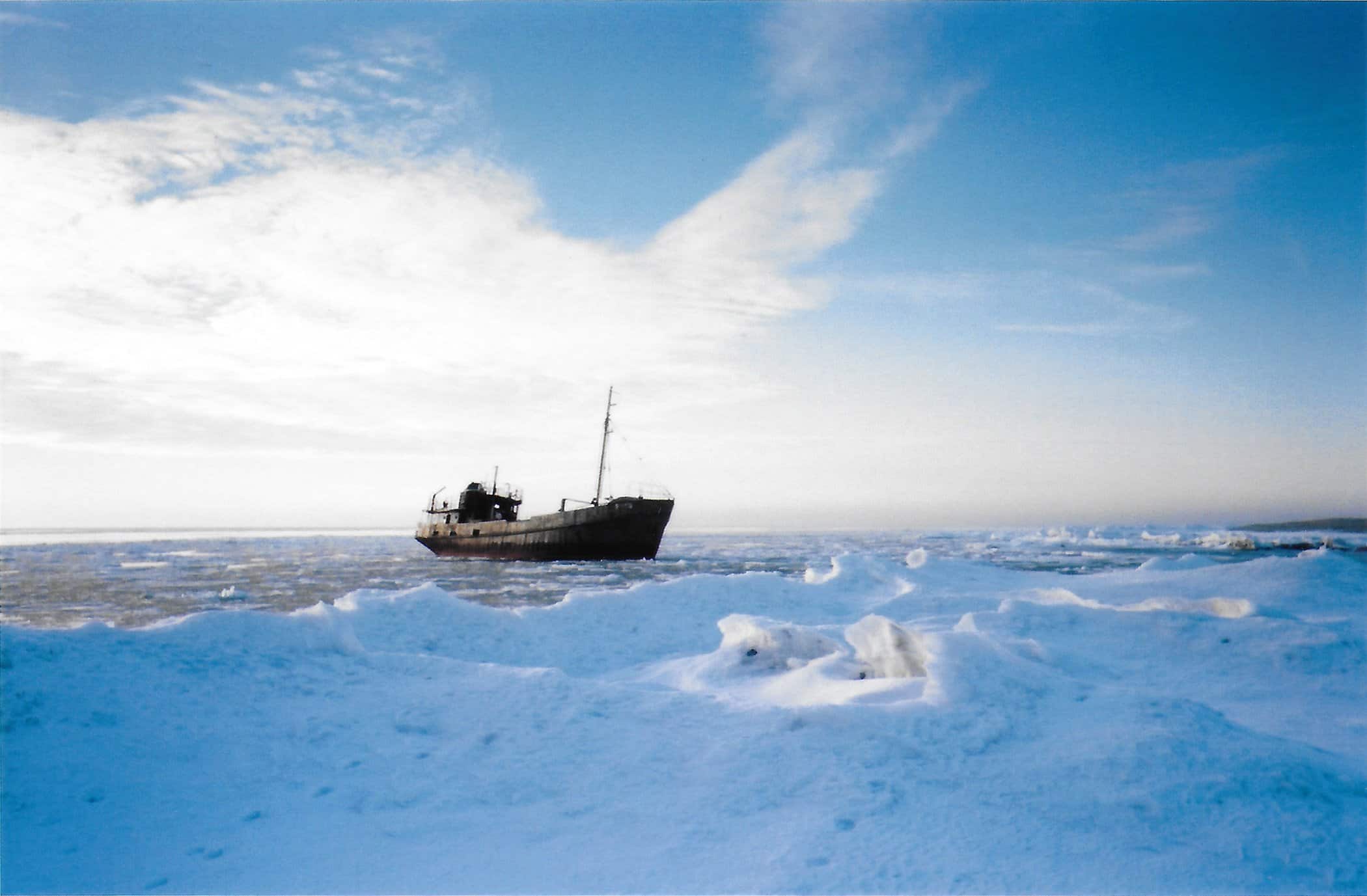
On the white Baltic, the sun closed in on the horizon. A fishing vessel—the Aries—tipped to one side, was bolstered by ice blocks thick as the concrete slabs of Brutalist monuments. There wasn’t another craft in sight, only the sea, flat as a salt-encrusted parking lot. Limestone cliffs surged from the water in severe verticality: this was the Baltic Klint, a mass of sedimentary rock unhindered by wind, tectonic jags and shifts. Where the waves froze at the base of the limestone cliff, a narrow trail of rocks and pebbles opened.
J scanned the path behind us as though he’d dropped something valuable in the clots of scrub grass and ice chunks. The pebbles under our boots contained an abundance of fossils. I pocketed one bone the length of my finger, warn smooth, and rubbed its osseous tissue until it absorbed the heat of my thumb. J folded the map. He asked if he could trust me with it, if I would zip it securely in my inside pocket. Of course I would. We were standing directly over the dock of the Soviet nuclear submarine base, its entry locked under the snow. Black cirrus strafed the flat blue sky over the smallness of our bodies, our negligible footprints where rebar bent from a blasted tower.
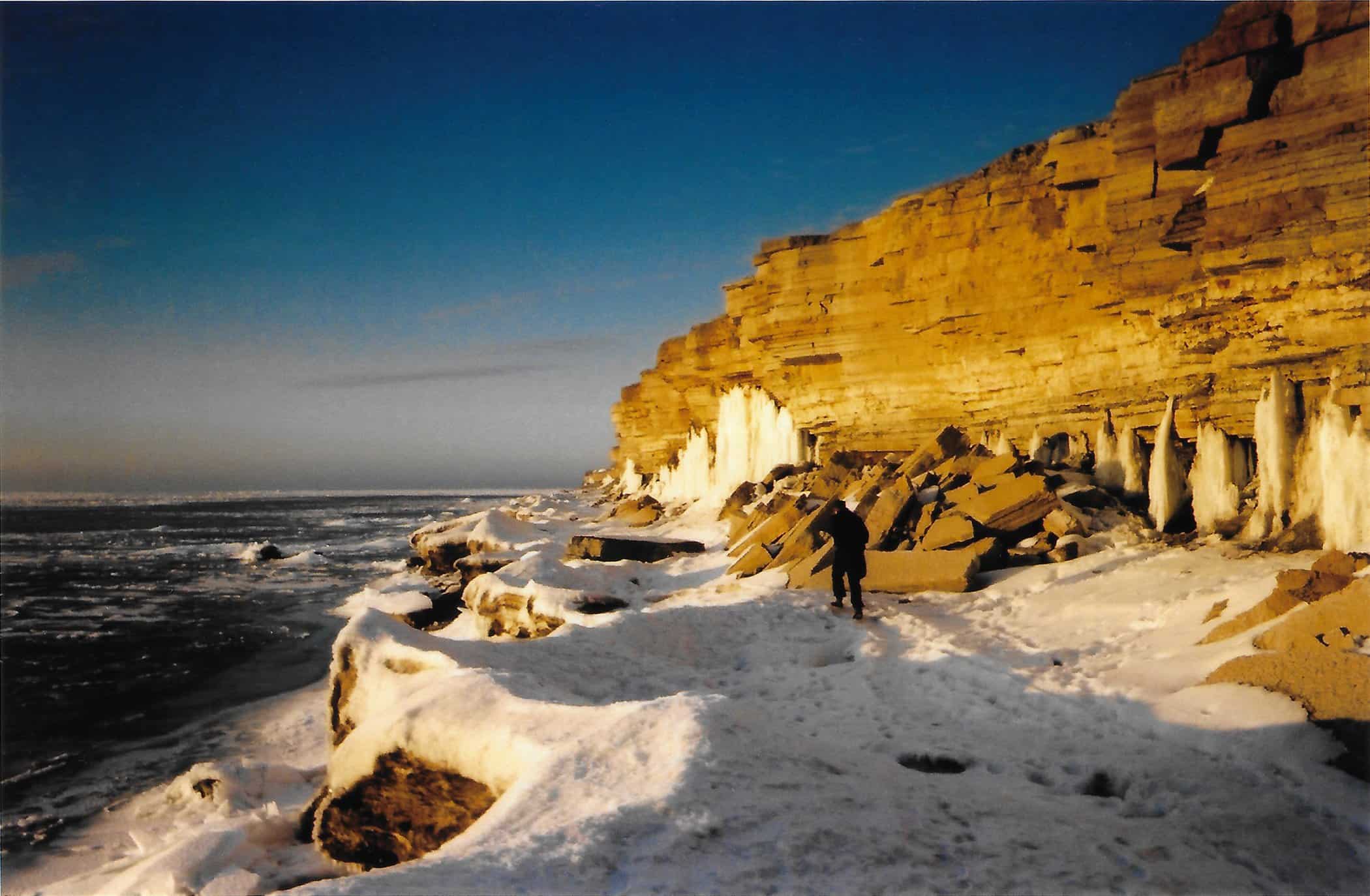
Water seeped from the cliff face. The brine electrified my hair. I couldn’t know exactly the moment at which I, too, would become permeable; I couldn’t hear its whisper; I heard only the wind’s incomprehensible drawl. I tried to decipher the feeling, its alphabet of faiths: that a language will unveil itself; that a person will make themselves recognizable; that desire, if true, can be transferred from the tyranny of wishing to the creation of beautiful works; that I love without knowing or naming; that a landscape will reciprocate with attention and patience and practice.
An origin story: As a child in New England, I followed stone walls deep into the woods where crumbled chimneys and rusted appliances lay in clearings among the oaks and maples, as though the walls of houses had vanished, leaving their hearths intact but exposed to sky. I imagined this was what happened to houses when families moved on from them: the foundation of my affinity for the neglected and my ambivalence toward continuity in poetic form. As a student, I wrote poetry in formal verse (haiku about candy and the terror advisory system, syllabic sonnets about the Tribute in Light, daydreams of stardom formatted in the Q&A dialogues of personality journalism). Eventually, my forms broke down. Fractured, spun out into lyrics more critical and associative. Permissive, rebellious.
I played among the rubbish. As the woods were developed, someone collected the trash; the trees were felled, stumps scraped, to bald the hills as McMansions soared into landscaped estate cul-de-sacs named Hampton Court, Falcon Crest, Sterling Ridge. The McMansions were all-threshold. Stand before the front door of a McMansion, then retreat to the street: from a 90-degree angle street view, the McMansion will appear depthless. For the passerby, the McMansion is a backdrop.
The entrances of Frederic Jameson’s Los Angeles Westin, its sky-blue cylindrical vessels, are obscure: the hotel is all volume, no door. Approaching the McMansion obliquely, as one would while passing anonymously in a car, one is seized by its conspicuous mass, incongruous with nature. How thirsty we are to offer a threshold into a superior experience.
For the invited visitor approaching the front atrium on foot, the McMansion is flat: all windows, all door. How thirsty we are to enter into our manipulated perspectives, our fabrications.
By the end of the aughts, I’d ditched both formal verse and the Q&As.
O pencil and pencil eraser.
O Wite-Out and ballpoint pen.
O Adam Smith and Wealth of Nations.
Sometimes it feels our personal property
is the only right we have.
Weil speaks of the nature of force, how it leads both victim and perpetrator of violence to experience violence as something that originates outside of themselves, beyond their physical strength or moral aptitude. Force transforms human actors into inhuman agents. The epic reinforces this transmutation through the use of similes which liken warriors to inhuman instruments: fire, flood, wind, or wild beasts—allowing the literary device to further annihilate human agency from acts of war.
In the continual “seesaw” between victory and defeat—each side of a conflict in turn culpable and innocent as each side advances and retreats—a “uniform horror,” a “wholesale slaughter” accrues. Aside from the “brief, celestial moments” where a human “possesses his soul” on the battlefield, war would be only a “monotonous desolation.” These moments of grace define a hero, a hero being a mortal who “awakes pure and whole,” if only for a brief duration, in the midst of destruction and obliteration.
The instant when a warrior jolts awake isn’t merely epiphanic. Weil goes on to list the ways in which the heroes of The Iliad, so close to becoming things, become conscious in their humanity. These junctures arrive in the form of hospitality, familial love, brotherly love, conjugal love, friendship between comrades, and friendships that bloom between enemies.
For Weil, a hero is a soul who awakens for a moment above a wasteland.
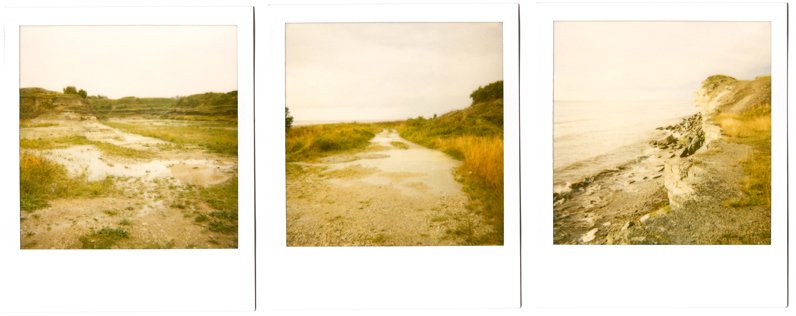
In 2010, I returned to the Baltic Klint in the summer months. I followed an asphalt path skirted by a chain-link fence to the water’s one point of access. The Aries remained moored at its station. The pebbles were gone. The ice path that J and I had followed along the base of the cliff had melted into the black brine that slapped against the escarpment. I surveyed the sediment at the tide line: no bones. The open land where we once dipped between troughs of snow to a bombed-out circle of rebar and concrete was gated and guarded. Europe had arrived with its euro and its clean, mobile technologies. The Pakri Peninsula would soon be host to white windmills, their aerodynamic blades snapping shadows across the once blighted fields. The economic struggle that had been visible early in the decade had been cleared from view.
When I’d photographed the Greenpoint Terminal Market, the Aries, the rebar and blasted tower with my disposable camera, I hadn’t yet known that a photograph of a ruin multiplies the ruin’s surfaces. I didn’t yet understand how abstraction could be both freedom and funeral for a figure. How a building’s declension to abstraction connotes a plea for a feral sincerity; how forms, when appropriated, are strip-mined of meaning; how I would trawl the language of immaterial structures, immaterial processes, the language of philosophy, and find the same kind of poetry.
At the beginning of the aughts, I wanted to subsume myself within the ruin’s field. I wanted to burrow my way into its center. By the end of the decade, I wanted to stand at the edge of the field, observe both the field and my observing it.
Maturity? Or a reaction to a decade of surveillance?
When Estonia joined the European Union in 2004, the national government was invited by the EU to contribute design proposals for one side of the euro coin. Designs selected by member countries drew from a variety of local pictorial sources, each image symbolizing its country’s history and identity. The Estonian government selected a jury to narrow the selection to ten designs and the final decision was put to the popular vote. The proposed coins depicted Estonian national symbols: the three lions featured on the Estonian national flag; the national bird, the barn swallow; the national flower, the cornflower; the gothic steeple of St. Olav’s tower, once the tallest building in the world; and a panoramic view of a rye field. More than 45,000 people (out of a population of 1.3 million) took part in the vote, the winning design selected by 27.6 percent of the population. In the end, the Estonian people chose an outline of the national map. The legal boundaries of post-occupation sovereign statehood. Not a national symbol, but the context in which a nation grows.
To some, the ruins of industry, the ruins of the military-industrial complex, are eyesores; to some, they are burial grounds, spirit gateways. For developers, they are pure potential: a golden capsule of airspace. Some ruins become state parks, national monuments. They remind us that the future prospers beyond our human ends, beyond capital’s desire to control the future, our experience of the future, and our access to it.
In the aughts, our ruins reintroduced the same necessities: our need to believe our constraints will dissolve, if not soon, eventually; the joy in the continuous evacuation of failed promises; the surety that what we create will outlast the force we harnessed to create it, even if piecemeal, even if fragment, and that the force that opposes what we make will ebb and fail in tandem; that our need to thread a continuous narrative through the world of things is an elegant definition of women’s intuition, or an economy; that the value of our symbols, our currency, is linked to our land; that the future exists beyond death, a solipsistic limit; that there exists space where entropy offers the possibility of peace.
The dominant quality of our industrial and modern centuries’ ruins is that they are seen with intensity. They are consequence made legible, tangible, global loss on a human scale. And as their rinds and cores are groomed, rezoned, I can only say: I breathed their capsized air. The centuries they embody are undeniable. When we agree to forget, we free ourselves of the past. What comes next is, by definition, uncertain.
